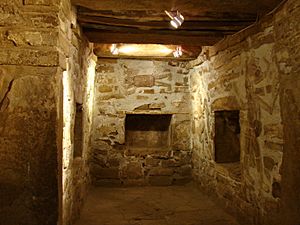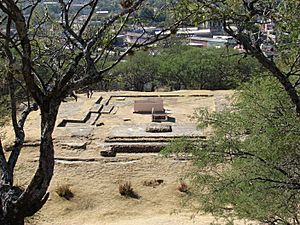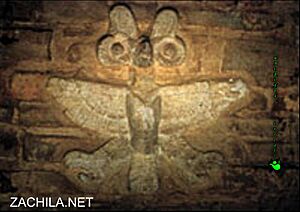Zaachila facts for kids

Zaachila was a powerful ancient city in what is now Oaxaca, Mexico. It's about 6 kilometers (4 miles) from the modern city of Oaxaca. The city gets its name from Zaachila Yoo, a Zapotec ruler from the late 1300s and early 1400s. Zaachila was also the home of Princess Donaji, who was the last Zapotec princess. Today, Zaachila is an important historical place. In the center, there's a large pyramid mound that hasn't been fully explored. Two ancient tombs were found there in 1962. These tombs are believed to belong to important Mixtec people.
Zaachila became the last capital city for the Zapotec people after their earlier capital, Monte Alban, declined. Later, the Mixtec people took control of Zaachila before the Spanish arrived. The exact history of this ancient city isn't fully clear. One idea is that the city was at its strongest between 1100 and 1521 AD. Another idea suggests it was founded in 1399. Some even compare it to Tenochtitlan, saying it was a city built in the middle of a lake. We don't know the full size of the ancient city because many of its old mounds now have buildings on top of them.
In 1971, new digs found two more tombs, called Tomb 3 and Tomb 4. The items found in these tombs were simpler than the first ones. But Tomb 4 was special because it had traces of paint on its entrance. Sadly, tree roots and rain have damaged these designs. Experts believe they showed skulls and crossbones on a red background. Since 1990, a special project has been studying and recording these ancient wall paintings, including those from Zaachila.
Today, people in Zaachila often trade goods instead of using money. Every Thursday, many merchants come to the town to exchange and sell their products.
The Big Zaachila Hill Festival
On the last Monday of July, the people of Zaachila gather at the archaeological site. This place is also known as "el cerrito," meaning "the little hill." They come together to honor the Corn Goddess, named Pitao Ko Shuub. This special event is called Laanii Roo Xten Daan Zaadxil.
A young woman is chosen to be the Corn Goddess for the festival. She is picked from several young women who enter a contest. To be chosen, she usually needs long black hair and brown skin. She also has to share a story about Zaachila's history. The chosen goddess then hosts all the festival activities.
Months before the festival, the ten neighborhoods of the town get ready. Young women practice to perform famous dances from different parts of Oaxaca. Some of these dances include "The Pineapple Flower of Tuxtepec" and "The Jarabe de Ejutla." There are also "Las Chilenas de la Coast" and "The Mixe Jarabe." Dances from the Isthmus of Tehuantepec are also performed. From the central valley, special dances like "The Dance of the Feather" and "Los Zancudos" are featured. "Los Zancudos" is unique because young men perform it on stilts that are almost five feet tall!
Local leaders are involved in this celebration. They provide special drinks and food to everyone taking part. These include tepache (a fruit drink), mezcal, atole (a warm corn drink), and tamales. This festival is one of the most colorful and fun events in the region. It includes cultural shows, parades, food tastings, and many other exciting activities.
Climate
| Climate data for Zaachila | |||||||||||||
|---|---|---|---|---|---|---|---|---|---|---|---|---|---|
| Month | Jan | Feb | Mar | Apr | May | Jun | Jul | Aug | Sep | Oct | Nov | Dec | Year |
| Mean daily maximum °C (°F) | 28.1 (82.6) |
29.7 (85.5) |
31.3 (88.3) |
32.0 (89.6) |
32.3 (90.1) |
29.8 (85.6) |
29.0 (84.2) |
29.1 (84.4) |
28.7 (83.7) |
27.7 (81.9) |
27.5 (81.5) |
27.3 (81.1) |
29.4 (84.9) |
| Mean daily minimum °C (°F) | 7.1 (44.8) |
9.6 (49.3) |
10.7 (51.3) |
12.7 (54.9) |
13.7 (56.7) |
14.5 (58.1) |
14.4 (57.9) |
14 (57) |
14.3 (57.7) |
13.1 (55.6) |
10 (50) |
7.6 (45.7) |
11.8 (53.2) |
| Average precipitation cm (inches) | 0 (0) |
0.51 (0.2) |
1.8 (0.7) |
4.3 (1.7) |
9.4 (3.7) |
14 (5.4) |
11 (4.3) |
10 (4) |
13 (5) |
4.1 (1.6) |
1.0 (0.4) |
0.25 (0.1) |
69 (27) |
| Source: Weatherbase | |||||||||||||
See also
 In Spanish: Zaachila for Kids
In Spanish: Zaachila for Kids



